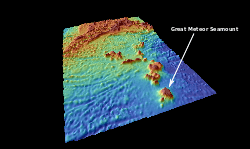Great Meteor Seamount
| Great Meteor Seamount | |
|---|---|
|
Great Meteor Seamount at the southern edge of the Atlantis-Meteor Seamount Complex | |
| Summit depth | 270 m |
| Height | 4500 m |
| Location | |
| Location | North Atlantic Ocean, 1000 km south of the Azores |
| Coordinates | 29°57′10.6″N 28°35′31.3″W / 29.952944°N 28.592028°WCoordinates: 29°57′10.6″N 28°35′31.3″W / 29.952944°N 28.592028°W |
| Geology | |
| Type | Guyot |
| Volcanic arc/chain | Seewarte Seamounts |
| History | |
| Discovery date | 1938 |
The Great Meteor Seamount is a large guyot (tablemount) located south of the Azores in the Atlantic Ocean. It is the New England hotspot's most recent eruptive center and is one of the most completely investigated seamounts in the world. This guyot rises up from a depth of almost 4,800 meters to about 270 meters below the surface of the Atlantic. The summit measures 50 km x 28 km (1465 km²).[1] On the southwest side it is flanked by the smaller Little Meteor Seamount[1] and the still smaller Closs Seamount.[2]
The German research vessel Meteor discovered the tablemount between 1925 and 1927. It was given the name Great Meteor Bank, a designation still used in the official GEBCO gazetteer.
Formation
The New England hotspot formed the White Mountains 124 to 100 million years ago when the North American continent was directly overhead. As the continent drifted to the west, the hotspot gradually moved offshore. On a southeasterly course, the hotspot formed Bear Seamount, the oldest in the chain, about 100 to 103 million years ago. Over the course of millions of years, it continued creating the rest of the seamounts, eventually culminating in the Nashville Seamount about 83 million years ago. As the Atlantic Ocean continued to spread, the hotspot eventually "traveled" further east, forming the Great Meteor Seamount where it is found today.[3]
Ecology
The unique ecological condition of the Great Meteor Seamount is shown by the many endemic copepod and nematode species.[4]
References
- ↑ 1.0 1.1 METEOR Retrieved on 2007-10-04
- ↑ Verhoef, Jaap (1984). "A Geophysical Study of the Atlantis-Meteor Seamount Complex". Geologica Ultraiectina 38: 1 – 153. ISSN 0072-1026. Retrieved 14 April 2014.
- ↑ "Geological Origin of the New England Seamount Chain". Office of Ocean Exploration and Research, National Oceanic and Atmospheric Administration. U.S. Department of Commerce. 2005. Retrieved 14 April 2014.Revised August 25, 2010 by the Ocean Explorer
- ↑ SPOTLIGHT 5 Great Meteor Seamount
